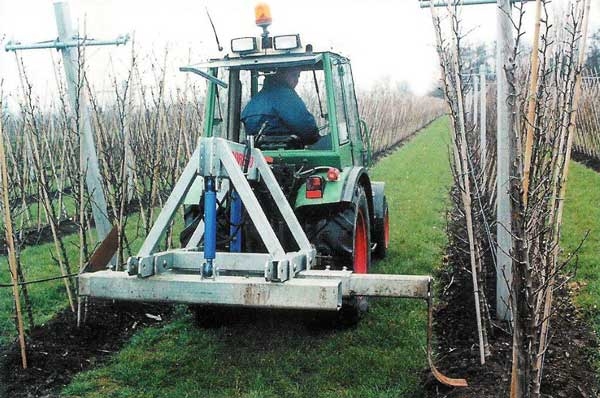Continued from last month: When root pruning, the roots of fruit trees are cut by dragging a cutting blade down the row near the trunks. Here are some problems you may run into when you prune roots:
- Trees that have been root pruned are easily stressed and need careful watering and feeding until their roots have re-grown. A heat wave after root pruning can be disastrous.
- Trees may die if too many roots are pruned particularly during a warm dry year. If not enough roots are pruned, excessive root development and shoot growth will be the result.
- The blade cutting through the soil has a tendency to pull the tractor into the tree row, particularly the first time. If the going is tough, even at 300 mm, start pruning the roots at a shallower depth.
- Root pruning in heavy sod is much more difficult than in an herbicide strip and almost always will require a second pass to finish the job.
- Low hanging branches or limbs can get damaged by the machine.
- Large roots just under the soil surface can catch on the blade instead of getting cut cleanly. When this happens the root will be pulled off the tree and often a good chunk of the bark on the tree will be stripped off with it.
- You have to make the right judgement in regard to where you are going to make the cut first time, because the cut roots will slide past the blade when you want to cut them closer to the trunk.
- For root pruning to be effective, the block of trees need to be uniform in growth, crop load and tree vigour.
- Pruning wounds are potential points of infection for fungi and bacteria.
- The amount of vegetative growth can be controlled by adjusting the depth of the cut and the distance from the cut to the trunks. The closer to the trunk the greater the effect.
Root pruning must be done on both sides of the tree within 500 or 600 mm of the trunk, and to a depth of 300 mm to 800 mm depending on depth of roots and soil type. Root pruning is effective when topsoil is shallow, and does not work well in deep fertile soils.
Root pruning eventually results in more root growth closer to the trunks and near the cuts as the trees regenerate after pruning. This is why root pruning is an on-going practice.
Root pruning should only be carried out as a last resort on trees that are out of control and yield poorly. But you need to ask yourself first, why the trees are out of control and/or yield poorly.
Root pruning would not be necessary if you:
- train and prune your young apple and pear trees in summer to fill their spaces in the orchard quickly
- develop a hierarchy in the tree’s framework
- crop the trees as soon as possible
- use drip irrigation
- use, as a back-up, growth regulators, i.e. Ethephon, paclobutrazol (Cultar, Payback), Regalis, Cytolin (Promalin, Perlin), gibberellic acid.
See this article and images in Tree Fruit October 2013






















